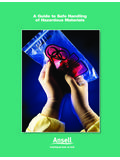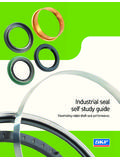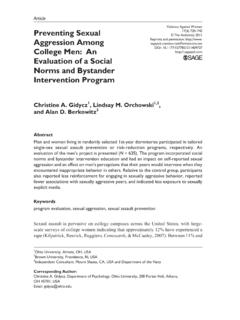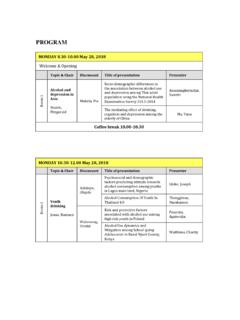Transcription of A SELF STUDY GUIDE - Ansell
1 A self STUDY GUIDEHAZARDSASSOCIATEDWITH GLOVEPOWDEROVERVIEW Glove powder includes dusting or donning powders, mold-release compounds, and manufacturing debris. Dry lubricants such as cornstarch, silicone etc., are used to make donning gloves easier and to prevent gloves from sticking together during the manufacturing process. Cornstarch, which meets the specifi cation for absorbable dusting powder in the United States Pharmacopoeia (USP), is the most common lubricant for medical gloves. Only absorbable dusting powders that have an approved Premarket Approval Application (PMA) or New Drug Application (NDA) may be used for lubricating surgeon s gloves. There are no comprehensive studies of the amount of absorbable dusting powder used on powdered gloves.
2 It is estimated that amounts of total particulates may range from 120 to 400 mg for a medium size powdered glove. (FDA Medical Glove Powder Report). Glove powder is composed of particles, thus, issues related to biologic responses to foreign bodies apply to both natural rubber latex (NRL) and synthetic gloves that are powdered. LEARNING OBJECTIVES Upon completion of this educational activity, the learner should be able to: 1. Discuss the history of medical gloves2. Identify the donning agents used in medical gloves and their weaknesses3. Explain the risks and complications associated with glove powder4. Identify the costs associated with glove powder5. Describe how powder-free gloves provide a solution to powder-related problemsINTENDED AUDIENCEThe information contained in this self - STUDY guidebook is intended for use by healthcare professionals who are responsible for or involved in the following activities related to this topic: Educating healthcare personnel Establishing institutional or departmental policies and procedures Decision-making responsibilities for safety and infection prevention products Maintaining regulatory compliance Managing employee health and infection prevention services INSTRUCTIONS Ansell Healthcare is a provider approved by the California Board of Registered Nursing, Provider # CEP 15538 for 2 (two) contact hours.
3 Obtaining full credit for this offering depends on completion of the self - STUDY materials on-line as directed below. Approval refers to recognition of educational activities only and does not imply endorsement of any product or company displayed in any form during the educational activity. To receive contact hours for this program, please go to the Program Tests area and complete the post-test. You will receive your certifi cate via 85% PASSING SCORE IS REQUIRED FOR SUCCESSFUL COMPLETION Any learner who does not successfully complete the post-test will be notifi ed and given an opportunity to resubmit for certifi cation. For more information about our educational programs or hand-barrier-related topics, please contact Ansell Healthcare Educational Services at 1-732-345-2162 or e-mail us at Planning Committee Members: Luce Ouellet, BSN, RNLatisha Richardson, MSN, BSN, RNPatty Taylor BA, RNPamela Werner, MBA, BSN, RN CNORAs employees of Ansell Mrs.
4 Ouellet, Mrs. Richardson, Mrs. Taylor and Ms. Werner have declared an affi liation that could be perceived as posing a potential confl ict of interest with development of this self - STUDY module. This module will include discussion of commercial products referenced in generic terms .. 2 INTRODUCTION .. 4 LATEX GLOVE HISTORY .. 5 POWDERED LUBRICANT HISTORY .. 7 TODAY S POWDERS .. 9 WASHING POWDERED GLOVES .. 9 HEALTH AND SAFETY CONCERNS .. 11 CONCLUSION .. 15 Ansell CARES .. 16 BIBLIOGRAPHY .. 17 HAZARDSASSOCIATEDWITH GLOVEPOWDERINTRODUCTIONBy the early 1900s the use of rubber gloves was common in the surgical suite in both Europe and the United States. Although the use of latex gloves in surgery became routine after World War I, gloves such as examination gloves, were not consistently used in other areas of patient care until the onset of the AIDS epidemic and the spread of hepatitis.
5 The increased incidence of hepatitis B, (HBV), hepatitis C (HCV) and AIDS (HIV) infections in the early to mid-1980s resulted in a tremendous increase of latex examination gloves although alternatives such as vinyl and technology for various synthetics existed. Latex examination gloves were proven to be one of the best methods of preventing transmission of HIV and hepatitis from infected patients to healthcare workers (HCWs). By 1987, the US Centers for Disease Control and Prevention (CDC) instituted Universal Precautions (today called standard precautions ) recommending the use of personal protective equipment (PPE) such as gloves, masks, gowns, and eye shields to prevent transmission of bloodborne pathogens to save lives and prevent injury or illness in the workplace.
6 This practice was quickly mandated in many countries by healthcare authorities 45 LATEX GLOVE HISTORYW illiam Halstead is the surgeon given credit for the introduction of surgical gloves in 1896. As chief of surgery at Johns Hopkins Hospital, his nurse, Caroline Hampton (later to become his wife), developed severe dermatitis from mercuric chloride, the disinfectant used to clean instruments and hands. As a result, he asked the Goodyear Rubber Company to make rubber gloves. These gloves were developed not to protect the patient but rather to protect the hands of those providing healthcare. Goodyear made two pairs of rubber gloves with gauntlets. They proved so effective in protecting Caroline Hampton s skin that they became a common item used in the operating room.
7 By chance Halstead s glove request coincided with early discoveries about the relationship between infection control and improved patient outcome. In 1847 in Paris, Semmelweis identifi ed a link between infection and death in maternity patients cared for by physicians who were not washing their hands. Further, in 1843 in the United States, Oliver Wendell Holmes became an advocate for various medical reforms and notably posited the controversial idea that the hands of doctors were capable of carrying puerperal fever from patient to early gloves were not the thin barrier protection of today. They were thick and reusable, sterilized by boiling, and donned over wet hands. As sterilization techniques were refi ned, wet glove over wet hand donning was eventually abandoned and the use of powdered lubricants came into fashion.
8 Gloves continued to be reused but were washed in mild soap, rinsed in distilled water, inspected for holes and tears, and then allowed to dry. They were then hand-powdered in a powder box before being wrapped and steam-sterilized. Extra powder packets were also available for the surgical team to apply to their hands just prior to , in 1966, single-use powdered gloves became available, and these continue to set the standard of care of latex from Hevea brasiliensis tree (latex rubber tree)and professional healthcare associations around the world and may have accounted for this tremendous increase in glove usage. Between 1987 and 1996, the use of NRL gloves among medical professionals rose by more than 1000% (McCall, 2003; CDC). In 1986, about 1 billion disposable gloves were sold worldwide ( Newsfl ).
9 In 2001, more than 30 billion pieces, including both latex and non-latex gloves, are manufactured every year. More than 20 billion of them, representing over $1 billion in purchases, are shipped to the United States. It is the single largest category of product sold by healthcare distributors. (Repertoire 2001). In 2008, more than 12 billion units of medical gloves were sold in the EMEA GLOVEPOWDERPRODUCTION OF GLOVES ( 000 PAIRS)YearTotal Gloves (All types)19893,186,79419903,592,02019914,43 9,01819926,490,20619939,726,77219946,566 ,40419956,991,78119968,204,62619979,010, 261199810,475,379199910,916,612200011,31 8,970200112,082,387200212,319,576200315, 051,026200418,219,298200519,146,84920062 0,570,058200720,570,666200822,585,554200 923,132,708201026,257,329201130,897,8402 01231,753,9782013*8,451,432* Jan-March Source: Department of Statistics, Malaysia672.
10 Eliminate Glove BlockingA powder may be used on the surface of the fi nished glove to keep the gloves from sticking to itself and to the glove package, also referred to as blocking. 3. Mold Release A powder used in slurry that coats the glove former at the beginning of production, so that the latex uniformly covers the former and the fi nished glove is able to be removed from the LUBRICANT AGENTSA variety of powdered lubricants have been used since 1890:Club mossLycopodium clavatum, or club moss, was one of the early glove lubricants in use by approximately 1890. Club moss was sometimes combined with talc to provide the powder necessary to ease the donning of latex gloves. With its use came early reports of complications, including tissue irritation, masses and powderFollowing this revelation, many glove manufacturers switched to a talc-only lubricant.









